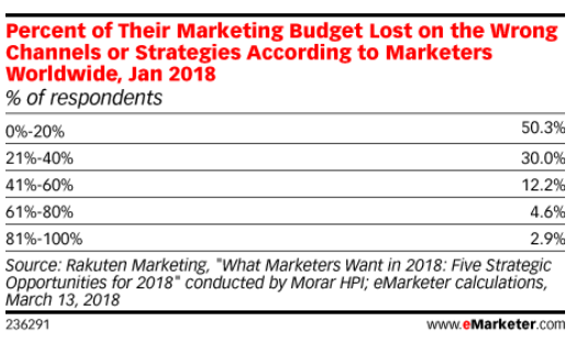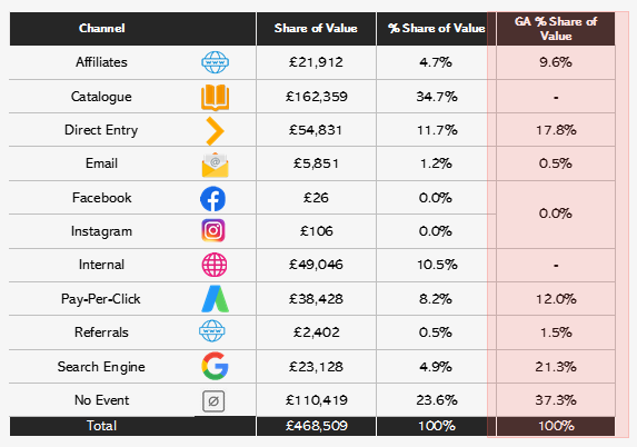
If accurate and timely marketing attribution is a critical success factor for all companies selling directly to consumers, why are so few companies achieving it, and what is needed to enable its delivery?
Let’s take a look at the key features we would expect to find in an accurate and timely marketing attribution solution:
- Flexible application to marketing channels
- Delivers views on customer segment effectiveness
- Transparent, easily understood workings
- Timely, easily interpreted results
- Representative of the whole customer base
- Robust data granularity for accurate return on marketing investment (ROMI) calculations
- Supports incremental performance reporting
- Sourced from an objective, independent provider
- Compliant with GDPR
Our observation of the tools that marketers use for attribution is that most would not pass muster if assessed by these criteria. Google’s GA and G4 both fail on most of them, and many agency attribution reports are clearly not holistic and independent sources of the truth.
Best practice at a glance
There are two well-known methodologies, both of which can provide valuable and accurate results, though they approach the problem from opposite ends of the spectrum.
Marketing Mix modelling (MMM), or econometrics as it is also called, looks at the macro picture of all marketing channels and combines their effects with that of other influencing factors like pricing, competition, external economic factors, weather and even epidemics in working out how each of these are contributing to, or subtracting from, sales.
MMM requires a long tail of data (up to three years) and some careful statistical analysis, however the results are highly informative. They can account for brand effects alongside the immediate effects of marketing, as well as explaining natural levels of demand when no marketing takes place. Because they are looking at the bigger picture, they don’t report immediately on campaign and test results.
As MMM reports are effectively handmade they are usually run quarterly, or even six monthly, so they don’t pass our timeliness criteria, but they can succeed on the others. The level of granularity across media, customer and product types can vary depending upon the statistical significance of the data splits.
Multi Touch Attribution (MTA), or customer journey-based marketing attribution, takes the micro view and examines all the known touch points between a company and a customer in the period leading up to a sale. As such it is limited to the kinds of direct channels that leave a data trail that can be linked to customers, and excludes indirect channels like TV or press.
It looks at the short-term effects of marketing, with its strength lying in its granularity. By examining the role played by each step in the customer journeys that lead up to a sale, it can see precisely where a particular campaign or test has influenced each journey, and hence give value to it based on its attributed fraction of the resultant sale.
These steps can be online, like visiting a website after clicking through from a social ad, or offline like receiving a catalogue or having an interaction with a call centre.
MTA can meet all our criteria, and provide very detailed campaign and test attribution, except for the omission of indirect channels like press and TV.
For companies spending material amounts on both direct and indirect channels there is no question then that they should deploy both MMM and MTA. However, it is also possible to fuse the macro and micro outcomes into one overall view of the value delivered by marketing. The results from the MMM will be used to remove value from the direct channels and reattribute it back to the indirect channels, from known information about the effect and timing of indirect marketing on different customers, products and sales channels.
So, is this what companies are doing?
It seems not.
Given that the best practice techniques are well known, and that there is a widespread acceptance that much of marketing budgets are wasted, it’s perplexing why so few companies go about setting up their own attribution reporting, and instead rely on the very incomplete and often biased results provided by Google.
Estimates vary regarding how much of marketing spend is wasted, but the consensus would appear to be at least a quarter. A Komarketing survey of marketers in 2019 found that 37 per cent acknowledged that much of their marketing budgets are wasted. And eMarketer, in the report below from Jan 2018, found that marketers believe they wasted on average 26 per cent.

In that case, what’s stopping them from looking for a better solution?
The most significant cause of marketers not setting up their own attribution is that Google is largely free and nearly universally available. It has become the common currency because so little cost or expense of effort is required to use it.
In contrast independent marketing attribution doesn’t come free. Let’s put that in context though – for marketers spending upwards of £1m pa, the costs start at less than 5 per cent of that budget. For marketers with a bigger budget like £10m pa, the costs are likely to be little more than 1-2 per cent. Those numbers reduce further if the mix of channels is relatively straightforward and MMM is not required. Compare that to the current scale of budget misallocation, and cost shouldn’t be a concern.
A second possible cause is that marketers just don’t realise that easily implemented alternatives to Google are available. There are challenges naturally; it takes expertise, for example, to set up the right environment and execute certain statistical processes. The good news is these experts are available and keen to undertake the work.
A third and possibly most significant cause is that misspending of budgets is often invisible. Marketers, having been led down the garden path by a combination of Google and their agencies, know that no one will challenge them if they sit back and accept the often misleading and inaccurate attribution results that they are used to receiving. When this is both free and effortless it’s all too easy for the impact to go unseen, and therefore unchallenged.
Is it really going to make much of a difference?
Absolutely!
To give an example of how Google can misrepresent results, we recently compared our own MTA reporting for a UK retailer with that provided by Google:

Catalogue sends and Internal (telephone) orders were not available to GA as it does not ingest personally identifiable information, despite constituting 45 per cent of the drivers of orders. GA gave Pay-Per-Click 46 per cent more value than our MTA, and Search Engine over four times as much contribution. As GA does not allow users to inspect how their calculations are made, we are not in a position to comment on their methodology, but it does appear to be strongly biased in favour of channels they own.
In conclusion, we suggest that marketers have for a long while been seriously misled by Google, and by their agencies using Google’s tools, over how their marketing is performing. Now that alternative methodologies are well known, and there are suppliers and in-house teams capable of providing attribution services, it is reasonable to expect that the status quo regarding marketing attribution is about to be seriously challenged.








Share